The challenges of growing grass in Azerbaijan
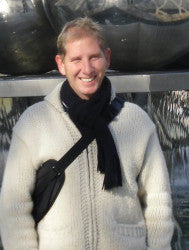 "I have learned that, if you understand the dynamics impacting growth and counteract them, you will find that you can manage turf successfully at just about any pH level"
"I have learned that, if you understand the dynamics impacting growth and counteract them, you will find that you can manage turf successfully at just about any pH level"
Phil Sharples, Stadium & Surfaces Manager, Gabala FC
Early 2010 started a normal enough year for me, little did I know what late 2010 and now 2011 had in store! To be the one and only professionally qualified groundsman in a country, in this day and age, is a rare thing!
October 2010 saw me flying out to Azerbaijan, after many meetings with Dave Saltman (MD of Pitchcare), as he had secured a contract to manage the grounds at Gabala FC. It was then that I began to start work, initially on a one year contractual basis, as the pitches manager for the club.
Some of you may already be familiar with the name Gabala FC, as it has been covered and discussed in the UK press after Tony Adams took over the reigns as the team manager back in early 2010.
The brief seemed simple enough; go and manage the training and, soon to be, stadium pitches for a Premiership Soccer Club in Azerbaijan - Gabala FC, and train Azeri national staff in the fine art of sports pitch management. With over twenty-two years experience in sports pitch management and golf course management, including nine years experience teaching Turfgrass Science in the UK, the challenge was perfect for me.
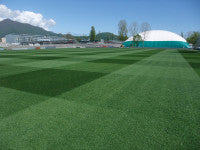 The club's facilities (to date) include five natural grass, full size soccer pitches; one full size 3G artificial; two small training 3G surfaces; one half size fully sealed and covered 'air dome' all weather 3G surface and, as I write (June 2011), we are in the final stages of finishing another one of two new natural pitches we are building this year. All surfaces on site are relatively new, with construction of the site and training facilities only beginning in early 2010.
The club's facilities (to date) include five natural grass, full size soccer pitches; one full size 3G artificial; two small training 3G surfaces; one half size fully sealed and covered 'air dome' all weather 3G surface and, as I write (June 2011), we are in the final stages of finishing another one of two new natural pitches we are building this year. All surfaces on site are relatively new, with construction of the site and training facilities only beginning in early 2010.
We will have three stadiums at the club, one seating around 2,000, one seating around 5,000 and the final, and biggest, seating around 15,000. The second stadium (Academy) will be completed by December of this year, and the largest stadium by summer 2012. The last two pitches built will have undersoil heating systems installed.
Initially, I came out to manage the surfaces only, but it was not long before I was in charge of the entire site. I now manage the club's entire infrastructure here in Gabala, from the existing stadium (that is currently being revamped) to the new build stadiums and all surfaces and services. I manage match days, security, personnel; in fact, everything to do with the grounds, stadium and the facility. I have fifteen staff (four for the pitches) and oversee all contractors visiting the site and the workforces they bring.
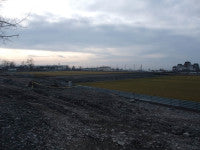
All natural surfaces are suspended water table construction with drains at 5m spacing, 150mm gravel raft, 200mm sand base and 100mm top layer (mixed with 10% peat); there is no blinding layer. The base sand layer incorporates about 8% fines, so has the ability to hold and exchange nutrients. All pitches have been built in the same manner using the most suitable sand we could find in Azerbaijan. To this end, sand was sourced from three quarries and sent to the UK for analysis before the final decision on which to use was made.
The sand we used has an excellent particle size distribution, giving us the water holding and drainage characteristics required, and is available in the quantities we need - building six full size natural turf pitches takes a lot of sand! - but, it has one undesirable characteristic - a pH of 8.8! Still, it met all other criteria, so we had no choice but to go with it.
Our pH issues do not end there. The irrigation water has a pH of 7.8 and the bicarbonate levels are off the scale! All this has forced us to think about the chemical nature and make-up of everything we apply to the surfaces, and the consequences of doing so.
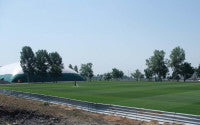 Being in Azerbaijan, we have no documented evidence of disease occurrence related to the local weather conditions encountered, significance of diseases on grass nor what pests may infest a grass stand. There is no statistical weather data we can reliably look back on, and there is no information on what grasses thrive here (that would be used in sports turf), or how best to manage them in this particular environment.
Being in Azerbaijan, we have no documented evidence of disease occurrence related to the local weather conditions encountered, significance of diseases on grass nor what pests may infest a grass stand. There is no statistical weather data we can reliably look back on, and there is no information on what grasses thrive here (that would be used in sports turf), or how best to manage them in this particular environment.
The high soil and water pH has required us to adapt the management styles we use, and ensure that decisions we make are the right ones for the longevity and health of the plant, whilst also encouraging the growth required to recover from wear. The high pH of the sand - which also doubles as our only topdressing material - has quite an impact on the growth and development of the plant. I have learned that, if you understand the dynamics impacting growth and counteract them, you will find that you can manage turf successfully at just about any pH level.
The challenges we needed to overcome did not end on the pitches either! It was vital that we quickly trained local people the skills required for the upkeep of professional football pitches. This was a challenge in itself, as the local population had only ever seen natural grass pitches on TV (if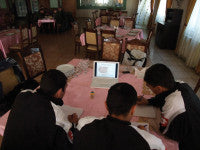 they were lucky enough to have one). Most games over here have traditionally been played on artificial turf. If they are played on grass, it's in a very poor condition. You would be amazed at some of the pitches I have seen football being played on!
they were lucky enough to have one). Most games over here have traditionally been played on artificial turf. If they are played on grass, it's in a very poor condition. You would be amazed at some of the pitches I have seen football being played on!
The skill base we had to choose from, for this type of work, was generally very poor. The average monthly salary here is around 300 Manat per month (around £250.00), with staff having a different work ethic from that which I'm used to in the UK. However, after a series of interviews, I was lucky enough to find four very keen guys who had the attitude I was looking for.
Training and development needed to occur quickly with the new ground staff so, whilst the winter weather did its worst, we studied at work, at my hotel, had formal lectures via powerpoint, and carried out general practicals on site as best we could - from tractor driving and machinery safety, to reversing trailers, to the maintenance of machinery and equipment. Intense and frequent formal lectures covered all subjects from plant morphology to soil moisture deficits. We covered about a year's worth of material (pitched at HNC level) in three months - it was an intensive time for the new recruits who, of course, all spoke good English.
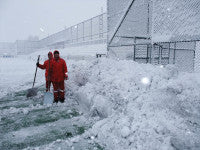
From October 2010 (when the first three pitches were initially established) until January 2011, we had no fertiliser or professional machinery at the club. This led to a steady decline in the quality of the training pitches due to the lack of post establishment maintenance. We then had nearly two full months of snow cover from January until the beginning of March 2011. This brought additional challenges when trying to keep the artificial surfaces in play and in top condition! By mid March, the natural pitches were ... well, a disaster! At the point of snow melt they were covered in pink snow mold, with at least 85% of the grass affected. All were straw like, yellow, patchy, thin and weak. We had a case of very poor establishment and, generally, they were atrocious to look at! Quite embarrassing for me really! Only artificial surfaces were used to train and play matches on at this time.
But, thankfully, at the end of the month, we had the 'majority' of the equipment we needed to work effectively - though not everything - the weather changed for the better, the soil temperature ramped up quickly and we were able to start the recovery plan.
All hands to the deck, we worked intensively on the pitches (they desperately required it), improvising where we needed due to lack of equipment and, of course, I was continuing to train the staff on best practice with turf machinery and renovation practices. It was a life saver for me that the pitches had been c onstructed professionally, with the right materials, the previous autumn. This definitely aided our management of them and allowed us to turn bad surfaces to excellent ones quickly.
onstructed professionally, with the right materials, the previous autumn. This definitely aided our management of them and allowed us to turn bad surfaces to excellent ones quickly.
The training of staff was tailored to ensure that they were completely competent using all the equipment at our disposal, and time was taken to make sure they understood the reasons for doing the job. I could not afford time lost due to poor workmanship on the surfaces.
Tony Adams wanted to use the training pitches at the beginning of May. The intensive staff training paid off, with no major mistakes or mishaps occurring on the pitches. The quality of workmanship carried out on them was up to the professional standards I required, and we met the deadline with ease. It was some turnaround, even if I do say so myself.
 Through the spring and summer of this year, we will continue to work on pitch quality, texture and density. Our goal and focus is to have outstanding surfaces unlike any seen here before, and a match for the best in Europe.
Through the spring and summer of this year, we will continue to work on pitch quality, texture and density. Our goal and focus is to have outstanding surfaces unlike any seen here before, and a match for the best in Europe.
Match pitch quality training surfaces are a must in my mind. Generally, my staff learn something new everyday and I am very proud of the quality of work they produce. The pitches would not be where they are today without them. I have very high standards when it comes to quality of pitches and they have all, genuinely, out-performed my expectations.
As I write, we are constructing a further two match pitches (SIS being our main contractors) and, by mid August, the first team will be playing all their home matches on natural grass; a first in their seven year history.
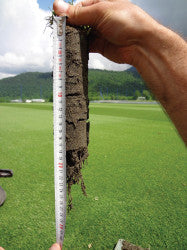
We will have a total of forty days to produce a match pitch from sowing seed, and all staff are looking forward to the challenge. On the new pitches, I will be incorporating about a tonne of calcium sulphate into the rootzone at construction stage, to see if we can make nutrients a little more available due to the pH issues we have.
In Azerbaijan, August brings with it near 40OC temperatures coupled with high humidity. I'm keeping my fingers crossed that our management plan works as we hope. The grasses we are maintaining here are Lolium perenne and Poa pratensis.
A side effect of the work we are producing is that the pitches are seen as something of a novelty in the country. We have frequent visits from the national press and TV, who all take an active interest in what we are doing, and all visitors to the club will, at some point, be found down by the training pitches looking at them and discussing what they see. I have no idea what they are talking about actually! I can only assume! My Azeri - a language made up of Turkish, Russian and local Azerbaijani - is enough to get by, but it is a country mile away from being fluent!
What we do here in Azerbaijan will never be a mirror image of the practices we use in the UK. There are some things that will always remain the same and no level of management will change them - and rightly so!
Being productive and effecting change is very much a case of being flexible, open-minded and finding solutions that fit  everyone's needs, wants and desires. Getting to know, and then understanding, the population's customs and culture was essential to allow me to adapt my management style and practices to get the results I needed. I learned this very quickly!
everyone's needs, wants and desires. Getting to know, and then understanding, the population's customs and culture was essential to allow me to adapt my management style and practices to get the results I needed. I learned this very quickly!
The role continues to bring new challenges every day, and the experience has forced me to think laterally on many levels. One thing I am sure of is, having worked in the US, mainland Europe and now Azerbaijan, the bug for working abroad is now firmly ingrained in my spirit and I look forward to what the future holds. I really don't think there is a better way to test your resolve!
Thanks for taking the time to read this and I wish you luck with your turf, wherever you may be.
Cheers. Phil Sharples, Stadium & Surfaces Director, Gabala FC
Azerbaijan - a brief history
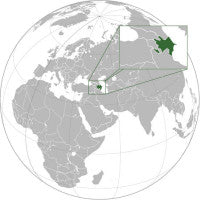 Oil-rich Azerbaijan gained independence from the Soviet Union in 1991 amid political turmoil and against a backdrop of violence in the region of Nagorno-Karabakh.
Oil-rich Azerbaijan gained independence from the Soviet Union in 1991 amid political turmoil and against a backdrop of violence in the region of Nagorno-Karabakh.
It has been famed for its oil springs and natural gas sources since ancient times, when Zoroastrians, for whom fire is an important symbol, erected temples around burning gas vents in the ground.
In the 19th century this part of the Russian empire experienced an unprecedented oil boom which attracted international investment. By the beginning of the 20th century Azerbaijan was supplying almost half of the world's oil.
In 1994, Azerbaijan signed an oil contract worth $7.4bn with a Western consortium. Since then Western companies have invested millions in the development of the country's oil and gas reserves. However, the economy as a whole has not benefitted as much as it might have done.
Caspian oil is now flowing through a pipeline running from Baku through Georgia to the Turkish port of Ceyhan, providing western countries with ready access to a vast new source of supply. Environmental groups have protested that the cost of this benefit is unacceptable.
Azerbaijan has large gas reserves too.
Azerbaijan became a member of the Council of Europe in 2001.
As the Soviet Union collapsed, the predominantly Armenian population of the Nagorno-Karabakh region stated their intention to secede from Azerbaijan. War broke out. Backed by troops and resources from Armenia proper, the Armenians of Karabakh took control of the region and surrounding territory.
In 1994 a ceasefire was signed. About one-seventh of Azerbaijan's territory remains occupied, while 800,000 refugees and internally displaced persons are scattered around the country.
Azerbaijan was in the media spotlight in June 2007 when Russian President Vladimir Putin offered the US the use of the Gabala radar station for missile defence as an alternative to using bases in Poland and the Czech Republic.
